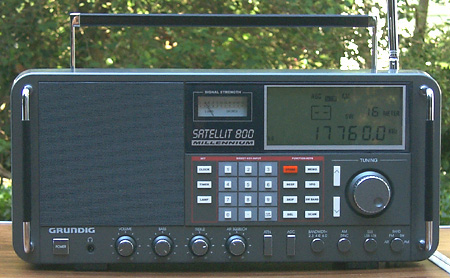
Year Introduced 2000 (1st Quarter)
Power 9 VDC @ 1 A: 120 VAC (60 Hz) or 230 VAC (50 Hz), auto-switching; or 6 D-cell batteries.
Size 50.6 cm W x 23.5 cm H with handle retracted x 22.6 cm W (21×9.25×8.5 inches)
Weight 6.6 kg (14.5 lb.) with power supply, no batteries.
Price US$500, refurbished US$400, CAN$600, £549, €975
Coverage 0.1-30 MHz (AM, SSB), 87-108 MHz (FM), 118-137 MHz (AM)
Value Rating star: 



This review was compiled independently. The Medium Wave Circle and Radio Netherlands has no financial connection with R.L. Drake, the manufacturer of this receiver.
Review by Thomas R. Sundstrom
The Grundig Satellit 800 Millennium receiver may well have been the most anticipated radio in the past few decades before shipping in early 2000. The radio is a combined engineering effort of Lextronix (California, USA) and R.L. Drake (Ohio, USA), and built in China.
From design to shipment, it is a convoluted history of a follow-up radio to the Satellit 650 and 700. The saga involves years, an abortive attempt to build a Satellit 900, a discontinued integrated circuit, a new design and uncounted delays in the ship date for re-engineering.
The receiver was finally released in limited production quantities at the beginning of the year. More units flowed to the three major US shortwave retailers in the second quarter, but it was not until the end of the year before the back orders were filled.
On July 11, 2000, we purchased a unit with the serial number S8005002709 off the shelf of a local USA retail specialty chain store Sharper Image.
What was our first impression? The radio is large and heavy. The shipping package weighs 11 kg. With apologies to General Motor’s recent ad campaign and noting the improper English… “this ain’t your father’s portable.”
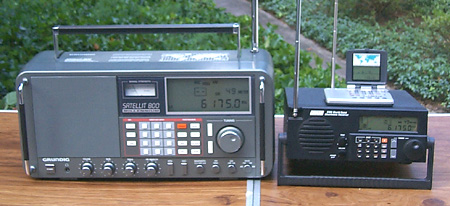
The Satellit 800 dwarfs the Drake SW8 and the tiny Sony ICF-SW07.
Our July 2000 review, frankly, was not favorable. While the Satellit 800 audio was quite good, there were issues of synthesizer noise, digital noise radiation from primarily the LCD and an unfiltered power supply to be dealt with. Mechanical quality control issues varied from receiver to receiver; these included knobs that wobbled, a unit that would not operate on battery power, and fit-and-finish items (such as a loose speaker grill).
Has the radio improved in the past two years? In September 2002, we can say “yes.” Here’s what we found.
UNPACKING THE BOX
Three cartons and Styrofoam inserts completely protected the radio and accessories. A pair of audio headphones – no “walkman-type” headphones or “ear buds” here – and a large “brick” power supply with two power cords (North America and Europlug) were included.
What was the first thing to fall out of the carton as we extracted the parts and pieces? It was a copy of Passport to World Band Radio. Interesting… we believe this supports our theory that the market for this radio is not the current shortwave listener but those business and executive persons who buy “toys” and might ask “what did I get myself into?”
THE FRONT PANEL
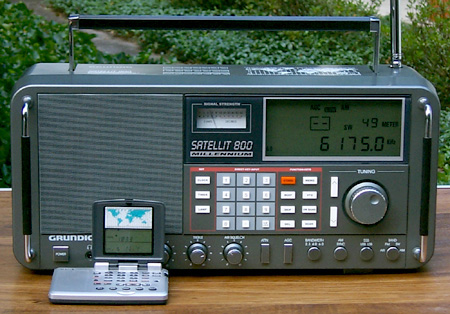
The Satellit 800’s speaker grill is larger than the Sony ICF-SW07. The grill and LCD display panel dominate the front panel. (The grill pattern and lighting plays tricks with the camera.) The s-meter sits in the top middle, and a keypad with associated pushbuttons is to the left of a tuning knob. The up- and down-arrow keys step through memories or step through frequencies.
On the AM band the receiver defaults to 10 kHz, but it may be changed to 9 kHz for Europe. Don’t lose the manual: with the receiver off, press and hold the SCAN button while pressing the POWER to toggle the frequency step.
Entering a frequency via the keypad is akin to the SW8. Press the keys to enter the frequency, and 1-to-2 seconds later the radio changes. Press the “.” key to immediately change the frequency.
The pushbuttons control 70 memories, clock and two-event timer functions.
The controls along the bottom of the receiver (left to right) are:
* power
* stereo headphone jack
* volume
* separate bass and treble controls
* a squelch knob for tuning the aircraft band
* push buttons for attenuator, automatic gain control, bandwidth (2.3, 4 and 6 kHz), AM sync, SSB (LSB and USB), and band (AIR, FM, SW and AM).
THE REAR PANEL
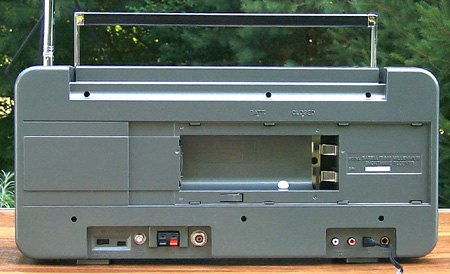
A large sliding panel, hiding the compartment for the optional six D-cell batteries, dwarfs the two cutouts for antenna, audio and power connectors. We took off the battery panel for this rear view.
At the lower left, one antenna switch for shortwave selects the whip and two external antennas (high and low impedance). The second switch for FM/AIR selects the whip or a 75-ohm external antenna.
At the lower right, the power connector separates the stereo speaker jack and separate (left and right channel) audio outputs. There is no mini plug to connect the receiver to a portable cassette recorder, nor is there a connector to control the recorder when using the timer functions.
The workarounds are (1) a separate clock to control the recorder, (2) a voice-activated tape recorder or (3) record onto the fixed disk of your PC. Though there are a number of multiple-event recording programs, for Windows, we like the inexpensive program Total Recorder by Highland Criteria.
SO HOW DOES THE RECEIVER PERFORM?
Simply put, the controls have the tuning characteristics of the Drake SW8 (discontinued in September 2000). Although there may be minor differences between the two sets, we found nothing of note. The filter set, the keypad and the AM synchronous selectable side band performance functions are easy to access.
As with the SW8, there is no noise blanker and no passband tuning.
The audio is outstanding and it sets the Satellit 800 apart from the other tabletops. (We cannot classify this radio as a portable due to its weight and size.)
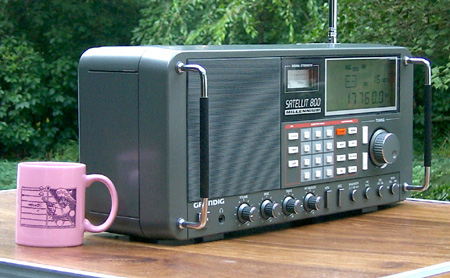
Late evening, before Midnight on the east coast of North America, our test signals are Radio New Zealand International on 17675 and some of the Voice of Russia relays from the Far East. We compared radios, using the whip antennas, side-by-side: the Satellit 800, Drake SW8, Sangean ATS-505 and Sony ICF-SW07. On a second look, the audio quality is much better than the JRC NRD-525 and on the DSP Ten-Tech RX-350. No surprise here, in either case. Without test instruments, our ears suggested that the Satellit 800 was slightly more sensitive than the SW8. Given the Satellit 800’s superior audio section, the audio certainly sounded better than the SW8. The SW07 topped the ATS-505 in signal strength, again no surprise, but the latter with the larger speaker had better audio. Adding headphones to the ICF-SW07 set things right.
Tuning through the 49-metre band, the Satellit 800 (and Drake SW8) had to fend off strong signals from Sackville, Antigua and Bonaire. The AM synchronous modes certainly helped, but in our opinion you would not want to make an evening listening to something 5 kHz away from these powerhouse stations.
FIT AND FINISH AND QUALITY NOTES
At first glance the radio’s fit and finish seemed fine. The display is huge; it can be read from across the room. The controls are widely spaced, quite a different approach to the smaller radios of today. We believe visually impaired and physically handicapped persons would have an easy time operating this radio.
In 2000, the tuning knob shaft wobbled significantly as the knob was turned. In 2002, that has been corrected with the use of high-quality ball bearings.
In 2000, a minor detail but we thought it was very odd and poor form to find the LCD’s display of the SSB indication to be a crude fix. To display “USB”, the latter’s display was effected by adding an “I” between the L and S thusly: LISB. That has not been corrected in 2002. Attention to detail is lacking.
THE YEAR 2002 PICTURE
The Satellit 800 receiver availability has changed, at least in North America. In August 2002, there were few receivers on the area Sharper Image retail store shelves. At our request, a store manager investigated. Sharper Image has discontinued carrying the receiver, and quantities on hand are limited to existing stock. There are two Sharper Image stock numbers; apparently one is for refurbished units.
What is a refurbished unit? These are receivers returned by customers unhappy with the radio, for whatever the reason. Drake, in Ohio, is doing the refurbishing. Grundig dealers sell the warranted units for less money (typically US $100) than new radios.
Although the radio is in a plastic case and still radiates digital signals from the LCD, the noise levels have decreased.
WHAT’S THE BOTTOM LINE?
The receiver section, born of Drake engineering, is quite acceptable. The audio performance is very good, typical of Grundig radios, and the radio is quite pleasant to listen to for hours on end.
We believe this receiver best serves the individual primarily interested in program listening. It lacks some of the creature comforts – notch filter, noise blanker, passband tuning, computer control – desired by listeners looking for DX (low-power or distant hard-to-hear) stations. The refurbished 800 has been adjusted for best performance and repaired if necessary, but a plastic case cannot offer an effective shield against the receiver “hash” when tuning in certain portions of some bands and the front panel LCD digital noise radiation.
For the listener also interested in tuning in DX stations, the tabletop ICOM IC-R75 has a street price that may be an interesting alternative choice (depending upon the country of purchase or monetary exchange rate). In September 2002, the IC-R75 sans options has a street price of US$600. However, the IC-R75 is not portable, and an external antenna is required.
Accordingly, in September 2002, with the caveats noted herein for the program-oriented listener, we award the Grundig Satellit 800 Millennium four stars.
This review first appeared on the Radio Netherlands website.